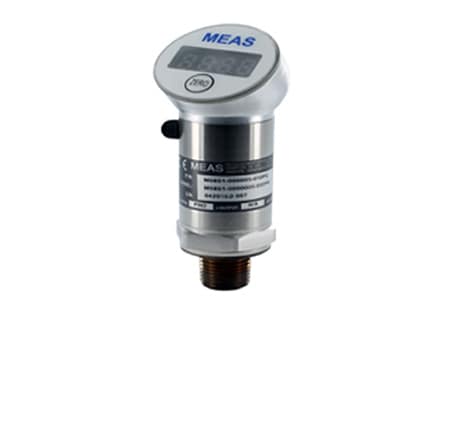Factories are becoming more autonomous and require sensors to monitor equipment on the factory. Watch this webinar to learn how sensors are capturing critical data for performance analytics, improved efficiency, lower costs, and better equipment utilization.

Application
Smart Sensors for Industry 4.0 and IIoT
TE Connectivity manufactures smart sensors with the packaging to support harsh environments, low current consumption, and a variety of measurement types to enable the growth of Industry 4.0 and IIoT.
Smarter Factories with Sensors
Smart sensors create an opportunity to read measurement properties to predict failure, monitor levels, and increase efficiencies to create a smart factory. Accurate measurements in harsh environments and conditions expand the reach of sensors to various types of equipment and processes. From miniaturized sensors with multiple digital output signals to wireless sensor technologies, TE offers various solutions to enable Industry 4.0 and the Industrial Internet of things (IIoT).

As industrial robotic automation advances, sensing technology will continue to be the foundation for data collection that will help transform manufacturing floors into the connected, cost-effective, and reliable factories of the future. Learn how sensors are driving this evolution.
Predictive Maintenance
Trend Monitoring
Monitoring sensor output signals over a period of time can offer insights into equipment failure. From bearing vibration to rising temperatures, as properties change, the decline in performance or need for part replacement can be predicted to avoid catastrophic failure, downtime, and cost. Filtration is another area of maintenance; as an example, differential pressure sensors can be used to monitor pressure across a filter to predict hydraulic or pneumatic filter maintenance.

For industrial condition monitoring and predictive maintenance applications vibration specification parameters are considered critical to ensure long-term, reliable, stable and accurate performance including: wide frequency response, measurement resolution, low drift, and operating temperature.
Download our white paper "Condition Monitoring: Vibration Sensor Technology Comparison" to learn how these paramaters apply to different vibration sensor types in IIoT applications.

Asset Monitoring
Keep Production Running
Certain manufacturing operations require assets and raw materials to build products. Sensors help confirm raw materials are available in inventory. A shortage in material can result in production downtime and potential loss down the supply chain. From the overall level to bubble detection, sensors are available to confirm assets are ready for use.

In many cases, assets in factories are stored in a liquid state. These liquids can be corrosive in nature, requiring special handling and management. If the sensor comes into contact with the liquid, it is required to be manufactured from compatible materials. Whether it is the factory or supplier of the chemicals that monitors the liquid level, submersible pressure transducers can be used to measure the hydrostatic level of the storage tank. When transmitted to the cloud, factories or suppliers can schedule deliveries to ensure production continues uninterrupted.
Building Automation
Efficiency with Sensors
Reducing cost and emissions in building controls continues to be a priority for many smart factories. Similar to smart home applications, sensors can provide data for pressure, temperature, and humidity to increase efficiencies in HVAC and refrigeration systems for the overall factory and factory equipment. From miniature digital sensors embedded in controls to wireless sensors installed in the process, TE provides a wide variety of sensor technologies and options to use for building automation applications.
Simple & Reliable Sensing Technology

Digital Output Options

ASIC Compensation
Sensors are an integral part of most heating, ventilation, air-conditioning, and refrigeration (HVACR) systems — helping to not only maintain a comfortable indoor climate but also to increase the efficiency of the HVAC systems. They also enable integration of HVAC systems with building automation systems.
Process Automation
Optimize
Traditional factories are evolving into smart factories by incorporating sensors. Replacing dial gauges with sensors allows for more accurate readings as well as collection of data in harsh areas. The data from sensors can enable Industry 4.0 process automation by collecting the data at a central point and optimizing systems based on feedback. Additionally, sensors are available with displays to understand conditions at the equipment.

Difficulty reading pressure measurements in awkward spaces throughout your process can compromise your operational efficiency. TE’s M5800 digital display transducer offers visualized pressure value readings for demanding , harsh applications. The 310° rotatable display enables easy viewing and on-demand adjustment.
Security
Safer Data Storage
Security of data continues to be a high priority related to Industry 4.0 and all elements of the Internet of Things. While the sensors provide the data, the transmission of the data through gateways and the cloud requires greater care.

High security data storage enclosures require reliable and effective means to detect and protect the system and it’s data against physical tampering. TE Connectivity (TE) tamper detection sensors offer a high security solution for physical data protection.
TE Connectivity tamper detection sensors (TDS) offer a high security solution in a space efficient form factor for the detection of physical tampering in small, high security enclosures.

Join Bernard Kamel, TE Connectivity's Wireless Sensor Engineering Manager, for an insightful journey into how these innovative devices are reshaping maintenance and monitoring practices.
Discover how the M5800 digital display pressure transducer offers precise measurements at a superior value, providing true control of your processes.
Start Designing
- Infographic: 5 Wireless Protocols to Consider for Your Next IoT Application (PDF)
- Differential Pressure Transducers for Filtration Applications
- Accelerometer Design Questions
- Sensor Development Boards
- Sensor Technology Webinars
- The Importance of Pressure Sensors in HVACR Systems
- Analog and Digital Transducers - The Advantages to Both



